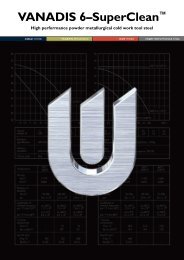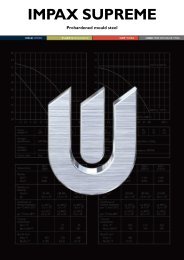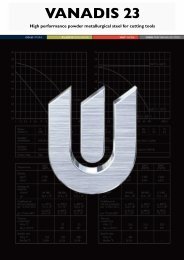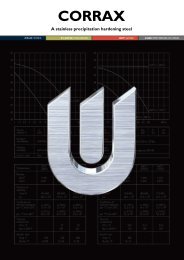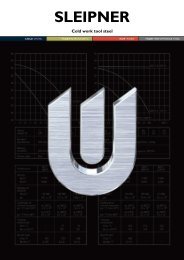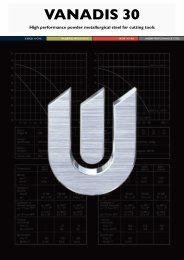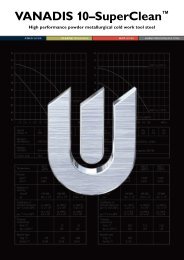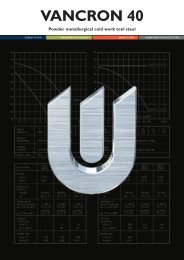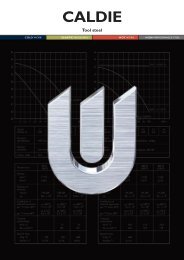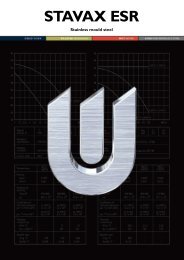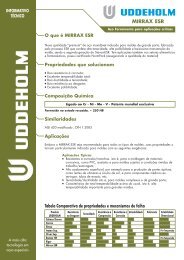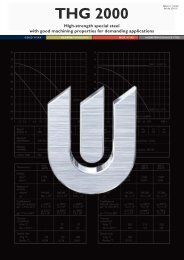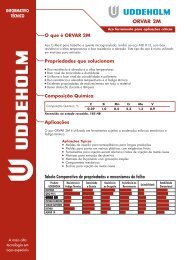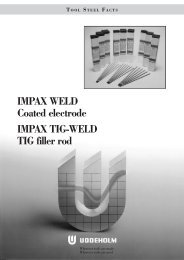Orvar supreme eng R-91905 - Uddeholm
Orvar supreme eng R-91905 - Uddeholm
Orvar supreme eng R-91905 - Uddeholm
Create successful ePaper yourself
Turn your PDF publications into a flip-book with our unique Google optimized e-Paper software.
UDDEHOLM ORVAR ® SUPREME
UDDEHOLM ORVAR SUPREME<br />
<strong>Uddeholm</strong> <strong>Orvar</strong> Supreme can be regarded as an “all-round” steel used<br />
in several application areas. Except for hot work application areas the<br />
steel is also used in moulds for plastics and as a material in high<br />
stressed axles.<br />
The high degree of purity and the very fine structure shows<br />
improvement in dies and components where high mechanical and<br />
thermal stresses are involved.<br />
This information is based on our present state of knowledge and is intended to provide general<br />
notes on our products and their uses. It should not therefore be construed as a warranty of<br />
specific properties of the products described or a warranty for fitness for a particular purpose.<br />
Classified according to EU Directive 1999/45/EC<br />
For further information see our “Material Safety Data Sheets”.<br />
Edition 7, 12.2009<br />
The latest revised edition of this brochure is the English version,<br />
which is always published on our web site www.uddeholm.com<br />
SS-EN ISO 9001<br />
SS-EN ISO 14001
UDDEHOLM ORVAR SUPREME<br />
General<br />
<strong>Uddeholm</strong> <strong>Orvar</strong> Supreme is a chromiummolybdenum-vanadium-alloyed<br />
steel which is<br />
characterized by:<br />
• High level of resistance to thermal shock<br />
and thermal fatigue<br />
•Good high-temperature str<strong>eng</strong>th<br />
•Excellent toughness and ductility in all<br />
directions<br />
•Good machinability and polishability<br />
•Excellent through-hardening properties<br />
•Good dimensional stability during hardening<br />
Typical C Si Mn Cr Mo V<br />
analysis % 0.39 1.0 0.4 5.2 1.4 0.9<br />
Standard<br />
specification Premium AISI H13, W.-Nr. 1.2344<br />
Delivery<br />
condition Soft annealed to approx. 180 HB<br />
Colour code Orange<br />
Improved tooling performance<br />
The name “Supreme” implies that by special<br />
processing techniques and close control, the<br />
steel attains high purity and a very fine structure.<br />
Further, <strong>Uddeholm</strong> <strong>Orvar</strong> Supreme<br />
shows significant improvements in isotropic<br />
properties compared to conventionally produced<br />
AISI H 13 grades.<br />
These improved isotropic properties are<br />
particularly valuable for tooling subjected to<br />
high mechanical and thermal fatigue stresses,<br />
e.g. die casting dies, forging tools and extrusion<br />
tooling. In practical terms, tools may be used at<br />
somewhat higher working hardnesses (+1 to<br />
2 HRC) without loss of toughness. Since increased<br />
hardness slows down the formation of<br />
heatchecking cracks, improved tool performance<br />
can be expected.<br />
<strong>Uddeholm</strong> <strong>Orvar</strong> Supreme meets the North<br />
American Die Casting Association (NADCA)<br />
#207-2006 for premium high quality H-13 die<br />
steel.<br />
Applications<br />
Tools for die casting<br />
Tin, lead Aluminium, Copper<br />
zinc alloys magnesium alloys<br />
Part HRC alloys, HRC HRC<br />
Dies 46–50 42–48 (QRO 90 S)<br />
Fixed inserts<br />
cores 46–52 44–48 (QRO 90 S)<br />
Sprue parts 48–52 46–48 (QRO 90 S)<br />
Nozzles 35–42 42–48 (QRO 90 S)<br />
Ejector pins<br />
(nitrided) 46–50 46–50 46–50<br />
Plunger,<br />
shot-sleeve<br />
(normally<br />
nitrided) 42–46 42–48 (QRO 90 S)<br />
Austenitizing 1020–1030°C 1040–1050°C<br />
temperature (1870–1885°F) (1900–1920°F)<br />
Tools for extrusion<br />
Aluminium, Copper Stainless<br />
magnesium alloys steel<br />
Part alloys, HRC HRC HRC<br />
Dies 44–50 43–47 45–50<br />
Backers, dieholders,<br />
liners,<br />
dummy blocks,<br />
stems 41–50 40–48 40–48<br />
Austenitizing<br />
temperature 1020–1030°C 1040–1050°C<br />
(approx.) (1870–1885°F) (1900–1920°F)<br />
Tools for hot pressing<br />
Material Aust. temp. (approx.) HRC<br />
Aluminium,<br />
magnesium 1020–1030°C (1870–1885°F) 44–52<br />
Copper alloys 1040–1050°C (1900–1920°F) 44–52<br />
Steel 1040–1050°C (1900–1920°F) 40–50<br />
3
UDDEHOLM ORVAR SUPREME<br />
Moulds for plastics<br />
Part Austenitizing temp. HRC<br />
Injection moulds 1020–1030°C (1870–1885°F)<br />
Compression/<br />
transfer moulds<br />
Tempering<br />
1. ≥ 550°C (1020°F) or 40–52<br />
2. 250°C (480°F) 50–53<br />
Other applications<br />
Application Austenitizing temp. HRC<br />
Severe cold<br />
punching, 1020–1030°C (1870–1885°F)<br />
scrap shears Tempering 250°C (480°F) 50–53<br />
Mechanical properties<br />
Approximate tensile str<strong>eng</strong>th at room<br />
temperature.<br />
Hardness 52 HRC 45 HRC<br />
Tensile str<strong>eng</strong>th 1820 MPa 1420 MPa<br />
Rm 185 kp/mm 2 145 kp/mm 2<br />
117 tsi 92 tsi<br />
263 000 psi 206 000 psi<br />
Yield str<strong>eng</strong>th 1520 MPa 1280 MPa<br />
Rp0.2 155 kp/mm 2 130 kp/mm 2<br />
98 tsi 83 tsi<br />
220 000 psi 185 000 psi<br />
Hot shearing 1020–1030°C (1870–1885°F)<br />
APPROXIMATE STRENGTH<br />
Tempering<br />
AT ELEVATED TEMPERATURES<br />
1. 250°C (480°F) or 50–53<br />
2. 575–600°C 45–50<br />
(1070–1110°F)<br />
Longitudinal direction.<br />
psi Rm, Rp0.2<br />
A5,<br />
Shrink rings<br />
1000x MPa<br />
Z %<br />
(e.g. for 1020–1030°C (1870–1885°F)<br />
290 2000<br />
100<br />
cemented Tempering 575–600°C 45–50<br />
carbide dies) (1070–1110°F)<br />
261 1800<br />
Z<br />
90<br />
232 1600<br />
80<br />
Wear- 1020–1030°C (1870–1885°F) Core<br />
203 1400<br />
70<br />
resisting parts Tempering 575°C (1070°F) 50–52<br />
Nitriding<br />
Surface<br />
174 1200<br />
60<br />
~1000HV 1<br />
145 1000<br />
Rm 50<br />
116 800<br />
40<br />
87 600<br />
Rp0,2<br />
30<br />
Properties<br />
58 400<br />
20<br />
29 200<br />
A5 10<br />
100 200 300 400 500 600 700 °C<br />
All specimens are taken from the centre of a<br />
210 390 570 750 930 1110 1290 °F<br />
407 x 127 mm (16" x 5") bar. Unless otherwise<br />
Testing temperature<br />
is indicated all specimens were hardened 30<br />
minutes at 1025°C (1875°F), quenched in air<br />
and tempered 2 + 2 h at 610°C (1130°F). The<br />
EFFECT OF TIME AT<br />
hardness were 45 ± 1 HRC.<br />
HIGH TEMPERATURES ON HARDNESS<br />
Hardness, HRC<br />
Physical data<br />
Data at room and elevated temperatures.<br />
50<br />
45<br />
Temperature 20°C 400°C 600°C<br />
500°C<br />
(68°F) (750°F) (1110°F)<br />
40<br />
Density<br />
kg/m 3 7800 7700 7600<br />
550°C<br />
35<br />
lbs/in 3 0.281 0.277 0.274<br />
600°C<br />
Modulus of<br />
elasticity<br />
30<br />
MPa 210 000 180 000 140 000<br />
psi 30.5 x 10 6 26.1 x 10 6 20.3 x 10 6<br />
25<br />
Coefficient of<br />
thermal expansion<br />
per<br />
°C from 20°C – 12.6 x 10 -6 13.2 x 10 -6<br />
°F from 68°F – 7.0 x 10 -6 7.3 x 10 -6<br />
Thermal<br />
conductivity<br />
W/m °C 25 29 30<br />
Btu in/(ft 2 h°F) 176 204 211<br />
650°C<br />
20<br />
1 10 100 1000<br />
Time, hours<br />
4
UDDEHOLM ORVAR SUPREME<br />
EFFECT OF TESTING TEMPERATURE<br />
ON IMPACT ENERGY<br />
Charpy V specimens, short transverse<br />
direction.<br />
ft lbs Impact energy, J<br />
74 100<br />
Stress relieving<br />
After rough machining the tool should be<br />
heated through to 650°C (1200°F), holding<br />
time 2 hours. Cool slowly to 500°C (930°F),<br />
then freely in air.<br />
59<br />
44<br />
30<br />
15<br />
80<br />
60<br />
40<br />
20<br />
45 HRC<br />
Hardening<br />
Pre-heating temperature: 600–850°C (1110–<br />
1560°F), normally in two pre-heating steps.<br />
Austenitizing temperature: 1020–1050°C (1870–<br />
1920°F), normally 1020–1030°C (1870–<br />
1885°F).<br />
0<br />
100 200 300 400 500 °C<br />
210 390 570 750 930 °F<br />
Heat treatment–<br />
general recommendations<br />
Soft annealing<br />
Testing temperature<br />
Protect the steel and heat through to 850°C<br />
(1560°F). Then cool in the furnace at 10°C<br />
(20°F) per hour to 650°C (1200°F), then freely<br />
in air.<br />
Temperature Soaking* time Hardness before<br />
°C °F minutes tempering<br />
1025 1875 30 53±2 HRC<br />
1050 1920 15 54±2 HRC<br />
* Soaking time = time at hardening temperature after the<br />
tool is fully heated through<br />
Protect the part against decarburization and<br />
oxidation during hardening.<br />
CCT GRAPH<br />
Austenitizing temperature 1020°C (1870°F). Holding time 30 minutes.<br />
°F<br />
2000<br />
1800<br />
1600<br />
1400<br />
1200<br />
1000<br />
800<br />
600<br />
400<br />
200<br />
°C<br />
1100<br />
1000<br />
900<br />
800<br />
700<br />
600<br />
500<br />
400<br />
300<br />
200<br />
100<br />
Ms<br />
Mf<br />
Martensite<br />
Karabider Carbides<br />
Austenitiseringstemperatur 1020°C<br />
Hålltid 30 minuter<br />
Perlit Pearlite<br />
Bainite<br />
Ac<br />
1f<br />
= 950°C<br />
Ac<br />
1s<br />
= 870°C<br />
1<br />
2 3 4 5 6 7 8 8<br />
1 10 100 1 000 10 000 Secondes Sekunder<br />
Kurva Curve<br />
Nr. No<br />
1<br />
2<br />
3<br />
4<br />
5<br />
6<br />
7<br />
Hardness<br />
HV 10<br />
681<br />
620<br />
606<br />
601<br />
585<br />
560<br />
537<br />
473<br />
T 800–500<br />
sek. sec.<br />
1<br />
37<br />
160<br />
280<br />
560<br />
1390<br />
3220<br />
8360<br />
1 10 100 1 Minutes 000Minuter<br />
1 10 Hours Timmar<br />
Air cooling of<br />
Luftkylning av<br />
0,2 1,5 10 90 bars Ø mm<br />
stänger, Ø mm<br />
5
UDDEHOLM ORVAR SUPREME<br />
Quenching media<br />
• High speed gas/circulating atmosphere<br />
•Vacuum (high speed gas with sufficient<br />
positive pressure). An interrupted quench is<br />
recommended where distortion control and<br />
quench cracking are a concern<br />
• Martempering bath or fluidized bed at<br />
450–550°C (840–1020°F), then cool in air<br />
• Martempering bath or fluidized bed at<br />
approx. 180–220°C (360–430°F) then cool<br />
in air<br />
•Warm oil<br />
Note 1: Temper the tool as soon as its<br />
temperature reaches 50–70°C (120–160°F).<br />
Note 2: In order to obtain the optimum<br />
properties for the tool, the cooling rate should<br />
be fast, but not at a level that gives excessive<br />
distortion or cracks.<br />
HARDNESS, GRAIN SIZE AND<br />
RETAINED AUSTENITE AS FUNCTIONS OF<br />
AUSTENITIZING TEMPERATURE<br />
Grain Hardness, HRC<br />
size 60<br />
ASTM<br />
Grain size<br />
10<br />
58<br />
56<br />
8<br />
Hardness<br />
54<br />
6<br />
52<br />
4 50<br />
48<br />
Restaustenit %<br />
Tempering<br />
Choose the tempering temperature according<br />
to the hardness required by reference to the<br />
tempering graph. Temper minimum twice with<br />
intermediate cooling to room temperature.<br />
Lowest tempering temperature 250°C (480°F).<br />
Holding time at temperature minimum 2 h.<br />
To avoid “temper brittleness”, do not temper<br />
in the range 425–550°C (800–1020°F), see<br />
graph.<br />
TEMPERING GRAPH<br />
Hardness,<br />
HRC<br />
60<br />
Austenitizing temperature<br />
1050°C (1920°F)<br />
55<br />
50<br />
45<br />
40<br />
35<br />
30<br />
25<br />
1020°C<br />
(1870°F)<br />
1025°C<br />
(1875°F)<br />
Retained austenite<br />
Retained austenite %<br />
100 200 300 400 500 600 700°C<br />
210 390 570 750 930 1110 1290°F<br />
Tempering temperature (2h + 2h)<br />
6<br />
4<br />
2<br />
46<br />
44<br />
Retained austenite<br />
6<br />
4<br />
42<br />
2<br />
40<br />
1000 1020 1040 1060°C<br />
1830 1870 1905 1940°F<br />
6
UDDEHOLM ORVAR SUPREME<br />
APPROXIMATE IMPACT STRENGTH AT<br />
DIFFERENT TEMPERING TEMPERATURES<br />
Charpy V specimens, short transverse<br />
direction.<br />
ft.lb.<br />
74<br />
59<br />
44<br />
30<br />
15<br />
Impact str<strong>eng</strong>th<br />
KV Joule<br />
100<br />
80<br />
60<br />
40<br />
20<br />
100 200 300 400 500 600 °C<br />
200 400 600 800 1000 1200 °F<br />
Tempering temperature (2h + 2h)<br />
Tempering within the range 425–550°C (800–<br />
1020°F) is normally not recommended due to<br />
the reduction in toughness properties.<br />
Dimensional changes<br />
during hardening<br />
Sample plate, 100 x 100 x 25 mm, 4” x 4” x 1”.<br />
Width L<strong>eng</strong>th Thickness<br />
% % %<br />
Oil hardened from<br />
Min. –0.08 –0.06 ±0<br />
1020°C (1870°F) Max. –0.15 –0.16 +0.30<br />
Air hardened from<br />
Min. –0.02 –0.05 ±0<br />
1020°C (1870°F) Max. +0.03 +0.02 +0.05<br />
Vac hardened from<br />
Min. +0.01 –0.02 +0.08<br />
1020°C (1870°F) Max. +0.02 –0.04 +0.12<br />
Dimensional changes<br />
during tempering<br />
Dimensional change %<br />
+0,12<br />
+0,08<br />
+0,04<br />
0<br />
–0,04<br />
–0,08<br />
–0,12<br />
100 200 300 400 500 600 700<br />
210 390 570 750 930 1110 1290<br />
Tempering temperature (1h + 1h)<br />
Nitriding and nitrocarburizing<br />
Nitriding and nitrocarburizing result in a hard<br />
surface layer which is very resistant to wear<br />
and erosion. The nitrided layer is, however,<br />
brittle and may crack or spall when exposed to<br />
mechanical or thermal shock, the risk increasing<br />
with layer thickness. Before nitriding, the<br />
tool should be hardened and tempered at a<br />
temperature at least 25–50°C (45–90°F) above<br />
the nitriding temperature.<br />
Nitriding in ammonia gas at 510°C (950°F)<br />
or plasma nitriding in a 75% hydrogen/25%<br />
nitrogen mixture at 480°C (895°F) both result<br />
in a surface hardness of about 1100 HV 0.2 .<br />
In general, plasma nitriding is the preferred<br />
method because of better control over nitrogen<br />
potential; in particular, formation of the<br />
so-called white layer, which is not recommended<br />
for hot-work service, can readily be<br />
avoided. However, careful gas nitriding can give<br />
perfectly acceptable results.<br />
<strong>Uddeholm</strong> <strong>Orvar</strong> Supreme can also be<br />
nitrocarburized in either gas or salt bath.<br />
The surface hardness after nitrocarburizing is<br />
900–1000 HV 0.2 .<br />
DEPTH OF NITRIDING<br />
Depth<br />
Process Time mm inch<br />
Gas nitriding 10 h 0.12 0.0047<br />
at 510°C (950°F) 30 h 0.20 0.0079<br />
Plasma nitriding 10 h 0.12 0.0047<br />
at 480°C (895°F) 30 h 0.18 0.0071<br />
Nitrocarburizing<br />
– in gas at<br />
580°C (1075°F) 2.5 h 0.11 0.0043<br />
– in salt bath at<br />
580°C (1075°F) 1 h 0.06 0.0024<br />
Nitriding to case depths >0.3 mm (>0.012 inch)<br />
is not recommended for hot work<br />
applications.<br />
<strong>Uddeholm</strong> <strong>Orvar</strong> Supreme can be nitrided in<br />
the soft-annealed condition. The hardness and<br />
depth of case will, however, be reduced somewhat<br />
in this case.<br />
Note: The dimensional changes in hardening<br />
and tempering should be added.<br />
7
UDDEHOLM ORVAR SUPREME<br />
Machining<br />
recommendations<br />
The cutting data below are to be considered<br />
as guiding values, which must be adapted to<br />
existing local conditions.<br />
More information can be found in the<br />
<strong>Uddeholm</strong> publication ”Cutting data recommendation”.<br />
Turning<br />
Turning with Turning<br />
carbide<br />
with high<br />
speed steel<br />
Cutting data Rough Fine Fine<br />
parameters turning turning turning<br />
Cutting speed (v c<br />
)<br />
m/min 200–250 250–300 25–30<br />
f.p.m. 660–820 820–985 82–100<br />
Feed (f)<br />
mm/r 0.2–0.4 0.05–0.2 0.05–0.3<br />
i.p.r. 0.008–0.016 0.002–0.008 0.002–0.012<br />
Depth of cut (a p<br />
)<br />
mm 2–4 0.5–2 0.5–2<br />
inch 0.08–0.16 0.02–0.08 0.02–0.08<br />
Carbide<br />
designation P20–P30 P10 –<br />
ISO Coated Coated<br />
carbide carbide<br />
or cermet<br />
Drilling<br />
HIGH SPEED STEEL TWIST DRILL<br />
Drill diameter Cutting speed, v c Feed, f<br />
mm inch m/min f.p.m. mm/r i.p.r.<br />
– 5 –3/16 16–18* 52–59* 0.05–0.15 0.002–0.006<br />
5–10 3/16–3/8 16–18* 52–59* 0.15–0.20 0.006–0.008<br />
10–15 3/8–5/8 16–18* 52–59* 0.20–0.25 0.008–0.010<br />
15–20 5/8–3/4 16–18* 52–59* 0.25–0.35 0.010–0.014<br />
* For coated HSS drill v c 28–30 m/min. (92–98 f.p.m.)<br />
CARBIDE DRILL<br />
Type of drill<br />
Cutting data Indexable Solid Brazed<br />
parameters insert carbide carbide 1)<br />
Cutting<br />
speed (v c )<br />
m/min 220–240 130–160 80–110<br />
f.p.m. 720–785 425–525 260–360<br />
Feed (f)<br />
mm/r 0.03–0.10 2) 0.10–0.25 2) 0.15–0.25 2)<br />
i.p.r. 0.001–0.004 2) 0.004–0.010 2) 0.006–0.010 2)<br />
1)<br />
Drill with replaceble or brazed carbide tip<br />
2)<br />
Depending on drill diameter<br />
Milling<br />
FACE AND SQUARE SHOULDER MILLING<br />
Milling with carbide<br />
Cutting data<br />
parameters Rough milling Fine milling<br />
Cutting speed (v c )<br />
m/min 180–260 260–300<br />
f.p.m. 590–850 850–985<br />
Feed (f z )<br />
mm/tooth 0.2–0.4 0.1–0.2<br />
inch/tooth 0.008–0.016 0.004–0.008<br />
Depth of cut (a p<br />
)<br />
mm 2–5 –2<br />
inch 0.08–0.20 –0.08<br />
Carbide designation<br />
ISO P20–P40 P10–P20<br />
Coated Coated<br />
carbide carbide or<br />
cermet<br />
END MILLING<br />
Type of end mill<br />
Carbide<br />
Cutting data Solid indexable High<br />
parameters carbide insert speed steel<br />
Cutting<br />
speed (v c )<br />
m/min 160–200 170–230 35–40 1)<br />
f.p.m. 525–660 560–755 115–130 1)<br />
Feed (f z )<br />
mm/tooth 0.03–0.20 2) 0.08–0.20 2) 0.05–0.35 2)<br />
inch/tooth 0.001–0.008 2) 0.003–0.008 2) 0.002–0.014 2)<br />
Carbide<br />
designation<br />
ISO – P20, P30 –<br />
1)<br />
For coated HSS end mill v c = 55–60 m/min. (180–195 f.p.m.)<br />
2)<br />
Depending on radial depth of cut and cutter diameter<br />
Grinding<br />
A general grinding wheel recommendation is<br />
given below. More information can be found in<br />
the <strong>Uddeholm</strong> brochure “Grinding of Tool<br />
Steel” and can also be obtained from the<br />
grinding wheel manufacturer.<br />
WHEEL RECOMMENDATION<br />
Soft annealed Hardened<br />
Type of grinding condition condition<br />
Face grinding<br />
straight wheel A 46 HV A 46 HV<br />
Face grinding<br />
segments A 24 GV A 36 GV<br />
Cylindrical grinding A 46 LV A 60 KV<br />
Internal grinding A 46 JV A 60 IV<br />
Profile grinding A 100 KV A 120 KV<br />
8
UDDEHOLM ORVAR SUPREME<br />
Welding<br />
Welding of tool steel can be performed with<br />
good results if proper precautions are taken<br />
regarding elevated temperature, joint preparation,<br />
choice of consumables and welding<br />
procedure.<br />
Welding method TIG MMA<br />
Working 325–375°C 325–375°C<br />
temperature 620–710°F 620–710°F<br />
Filler metal<br />
Cooling rate<br />
QRO 90 TIG-WELD<br />
DIEVAR TIG-WELD<br />
QRO 90 WELD<br />
20–40°C/h (35–70°F/h) the first 2–3 h<br />
then freely in air.<br />
Hardness<br />
after welding 50–55 HRC 50–55 HRC<br />
Heat treatment after welding<br />
Hardened Temper at 10–20 °C (20–40°F) below<br />
condition the original tempering temperature.<br />
Soft annealed Soft-anneal the material at 850°C<br />
condition (1560°F) in protected atmosphere.<br />
Then cool in the furnace at 10°C<br />
20°F) per hour to 650°C (1200°F)<br />
then freely in air.<br />
More detailed information can be found in the<br />
<strong>Uddeholm</strong> brochure “Welding of Tool Steel”.<br />
Electrical-discharge<br />
machining<br />
If spark-erosion is performed in the hardened<br />
and tempered condition, the white re-cast<br />
layer should be removed mechanically e.g. by<br />
grinding or stoning. The tool should then be<br />
given an additional temper at approx. 25°C<br />
(50°F) below the previous tempering temperature.<br />
Hard-chromium plating<br />
After plating, parts should be tempered at<br />
180°C (360°F) for 4 hours within 4 hours of<br />
plating to avoid the risk of hydrogen<br />
embrittlement.<br />
Polishing<br />
<strong>Uddeholm</strong> <strong>Orvar</strong> Supreme exhibits good<br />
polishability in the hardened and tempered<br />
condition. Polishing after grinding can be<br />
effected using aluminium oxide or diamond<br />
paste.<br />
Typical procedure:<br />
1. Rough grinding to 180–320 grain size using a<br />
wheel or stone.<br />
2. Fine grinding with abrasive paper or powder<br />
down to 400–800 grain size.<br />
3. Polish with diamond paste grade 15 (15µm<br />
grain size) using a polishing tool of soft<br />
wood or fibre.<br />
4. Polish with diamond paste 8–6–3 (8–6–3µm<br />
grain size) using a polishing tool of soft<br />
wood or fibre.<br />
5. When demands on surface finish are high,<br />
grade 1 (1µm grain size) diamond paste can<br />
be used for final polishing with a fibre<br />
polishing pad.<br />
9
UDDEHOLM ORVAR SUPREME<br />
Photo-etching<br />
<strong>Uddeholm</strong> <strong>Orvar</strong> Supreme is particularly<br />
suitable for texturing by the photo-etching<br />
method. Its high level of homogeneity and low<br />
sulphur content ensures accurate and consistent<br />
pattern reproduction.<br />
Further information<br />
Please contact your local <strong>Uddeholm</strong> office<br />
for further information on the selection, heat<br />
treatment, application and availability of<br />
<strong>Uddeholm</strong> tool steels.<br />
10
Network of excellence<br />
UDDEHOLM is present on every continent. This ensures you<br />
high-quality Swedish tool steel and local support wherever you<br />
are. ASSAB is our wholly-owned subsidiary and exclusive sales<br />
channel, representing <strong>Uddeholm</strong> in various parts of the world.<br />
Together we secure our position as the world’s leading supplier<br />
of tooling materials.<br />
www.assab.com<br />
www.uddeholm.com
UDDEHOLM 091202.300 / TRYCKERI KNAPPEN, KARLSTAD 200912127<br />
UDDEHOLM is the world’s leading supplier of tooling materials. This<br />
is a position we have reached by improving our customers’ everyday<br />
business. Long tradition combined with research and product development<br />
equips <strong>Uddeholm</strong> to solve any tooling problem that may arise.<br />
It is a chall<strong>eng</strong>ing process, but the goal is clear – to be your number one<br />
partner and tool steel provider.<br />
Our presence on every continent guarantees you the same high quality<br />
wherever you are. ASSAB is our wholly-owned subsidiary and exclusive<br />
sales channel, representing <strong>Uddeholm</strong> in various parts of the world.<br />
Together we secure our position as the world’s leading supplier of<br />
tooling materials. We act worldwide, so there is always an <strong>Uddeholm</strong><br />
or ASSAB representative close at hand to give local advice and support.<br />
For us it is all a matter of trust – in long-term partnerships as well as in<br />
developing new products. Trust is something you earn, every day.<br />
For more information, please visit www.uddeholm.com, www.assab.com<br />
or your local website.



